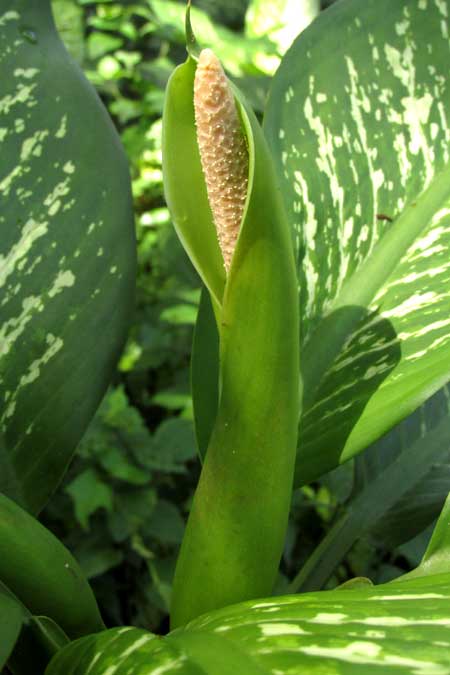Excerpts from Jim Conrad's
Naturalist Newsletter
from the January 18, 2019 Newsletter with notes from an October, 2018 camping trip into Chiapas, the southernmost state of MÉXICO
DUMBCANE
During my camping trip to Chiapas, on last October 5th, something interesting turned up among much-shaded weeds along the road between Palenque town and Palenque ruins. It was a small cluster of aroids -- members of the Arum or Jack-in-the-pulpit Family -- with especially pretty leaves, shown below:

In that picture, notice the flowering structure rising from amid the juncture of the leaves' petioles. A close-up is shown below:

As typical of the Arum or Jack-in-the-pulpit Family, the flower structure consists of a green, leafy thing (the spathe) wrapped around a white, slender flower spike (the spadix). Those familiar with the North American wildflower Jack-in-the-pulpit will recognize the white spadix as Jack, and the green spathe as the pulpit. The white spadix is covered with hundreds of tiny, very closely crammed flowers. In this species, male flowers occupy the spadix's top, while female ones occur at the bottom, with a row of sterile flowers separating the two sexes.
I wasn't sure whether these roadside plants were wild native plants, or escaped ornamentals, or maybe relics from a long-disappeared home garden. In Chiapas' hot, humid lowlands, such pretty native plants can occur.
The plant's general form -- leaves arising from a short stem rooted in the ground (not a vine and not arboreal) -- and features of the spathe and spadix, suggested the genus Dieffenbachia. Dieffenbachia is native to tropical American, with certain species occurring in Mexico. I'm familiar with Dieffenbachia because some of its species are grown as potted plants in the Temperate Zone, and I used to have one.
This turned out to be DIEFFENBACHIA AMOENA, amoena meaning "charming" or "pleasing." Dieffenbachia amoena isn't native to Veracruz state, for which the family has been well documented, so I'm guessing that it's native to farther south than Chiapas. Also I'm assuming that someone planted them along the road to Palenque ruins, so they weren't growing wild.
All 56 or so species of Dieffenbachia can be called dumbcane, not because they're stupid, but because if you bite into them your mouth will instantly start hurting and cause such numbness that you'll be unable to speak, and in that sense "dumb," as in "deaf and dumb."
That's because Dieffenbachia cells contain needle-shaped calcium oxalate crystals called raphides. I've tested the effect and it does feel like hot needles stabbing into the mouth, especially below the tongue. Sometimes people say that the compounds in Dieffenbachia are deadly poisonous, but they're not. They just hurt, the pain is temporary, and only rarely does reddening and swelling of tissue result. In most cases, symptoms can be treated with the usual household analgesics, antihistamines, or even medical charcoal.
By the way, the name Dieffenbachia honors a gardener of the 1800s, J.F. Dieffenbach, a German physician and botanist working at Schönbrunn gardens in Vienna, Austria.